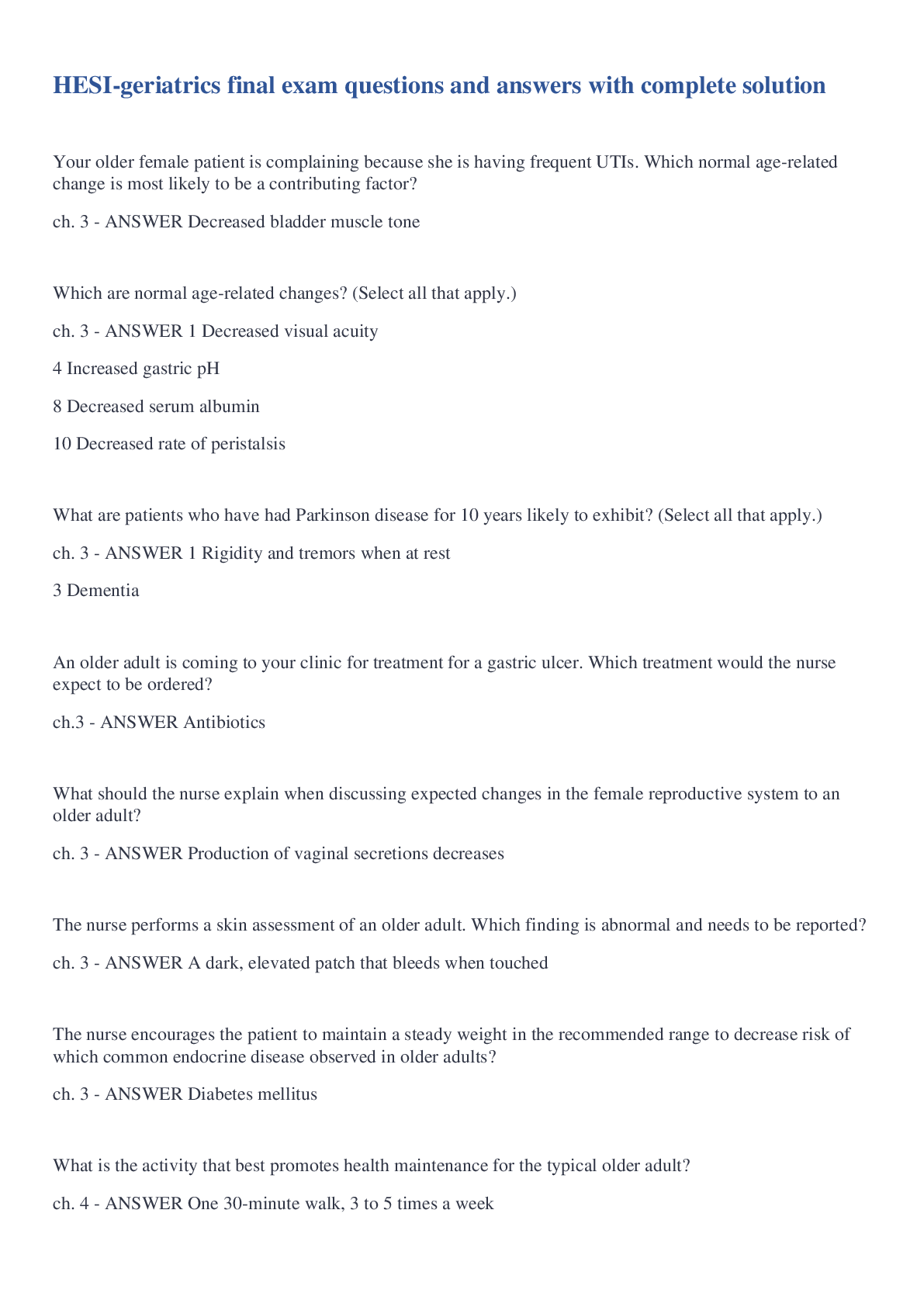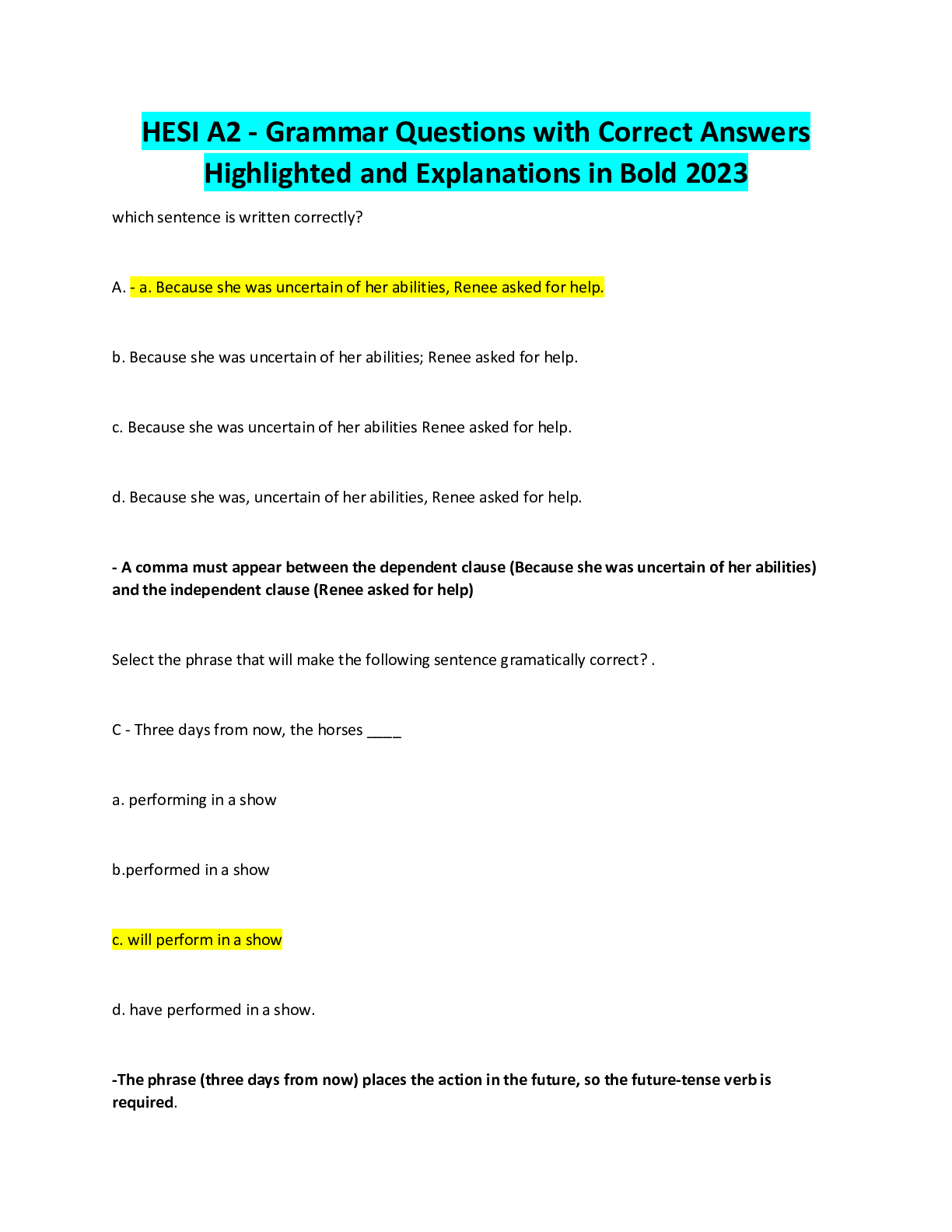HESI PN Exit practice Q&A
Document Content and Description Below
The practical nurse (PN) is caring for a client with Graves' disease. The PN should expect which findings with this client? - ANSWER Characteristics of Graves' disease include exophthalmos, heat intol... erance, and soft smooth skin and hair in addition to weight loss, nervousness, and fine tremors of the hands. A client has a serum potassium level of 3 mEq/L. Which findings should the practical nurse report to the charge nurse? (Select all that apply.) A. Muscle cramps B. Diarrhea C. Altered blood glucose level D. Increased energy E. Abnormal heart rhythms F. Increased anxiety - ANSWER A. Muscle cramps E. Abnormal heart rhythms Rationale: A normal potassium level ranges from 3.5 to 5 mEq/L (mmol/L). Signs and symptoms of low potassium include muscle cramps and dysrhythmias. A client diagnosed with diabetes mellitus complains of vomiting and feeling confused to the practical nurse. Which of the following symptoms are possible signs of diabetic ketoacidosis (DKA)? (Select all that apply.) A. Fruity breath odor B. Rapid, weak pulse C. Cold, clammy skin D. Extreme thirst E. Urinary frequency F. Protruding eyeballs - ANSWER A. Fruity breath odor B. Rapid, weak pulse D. Extreme thirst E. Urinary frequency Rationale: Diabetic ketoacidosis is caused by a profound deficiency of insulin. Some common characteristics include a sweet, fruity breath odor; a rapid weak pulse; extreme thirst; urinary frequency; and sunken-appearing eyeballs. What is the depth of the compression the practical nurse (PN) should do when performing the manual chest compressions during cardiopulmonary resuscitation (CPR) on an adult client? A. 0.5 inch (1.27 cm) to 1 inch (2.54 cm) B. 1.5 inch (3.8 cm) to 2 inches (5 cm) C. 2 inches (5 cm) to 2.4 inches (6 cm) D. 2.5 inches (6.4 cm) to 3 inches (7.6 cm) - ANSWER C. 2 inches (5 cm) to 2.4 inches (6 cm Rationale: According to the American Heart Association 2015 guidelines, the depth of compressions on an adult during CPR should be at least 2 inches (5 cm) to 2.4 inches (6 cm). A client diagnosed with a skull hematoma and fractured (L) clavicle status post a six foot fall from a ladder is admitted to the unit. Which sign should the practical nurse (PN) report immediately? A. Spontaneously opens eyes .B. Obeys commands in movement and grip. C. Answers questions, but is confused. D. Has abnormal flexion or extension of (L) arm. - ANSWER C. Answers questions, but is confused. Rationale: "The question ask which should be report immediately?" An abnormal change in condition related to Dx. Confusion status post a head injury is usually the first sign of increased intracranial pressure. A client diagnosed with duodenal ulcers is admitted to the hospital. The client was administered ranitidine hydrochloride 150 mg PO at bedtime. Which finding would indicate a therapeutic response of the medication? A. Gastric secretions pH level below 3. B. Hemoccult testing is positive on two different occasions. C. No difficulty falling asleep reported. D. No complaints of abdominal pain or heartburn verbalized. - ANSWER D. No complaints of abdominal pain or heartburn verbalized. Rationale: It is asking to indicate a therapeutic response of the medication. so know your medications. Lack of abdominal pain within 4 hours after meals indicates decreased duodenal irritation, a positive outcome in the treatment of duodenal ulcer. A client diagnosed with diabetes complains to the practical nurse of decreased tactile sensation in their feet and feelings like their feet are on fire sometimes. Which abnormal laboratory finding should the practical nurse (PN) identify that indicates that a client with diabetes needs further evaluation for diabetic nephropathy? A. Hypokalemia B. Microalbuminuria C. Elevated serum lipids D. Ketonuria - ANSWER Rationale: Microalbuminuria is the earliest sign of diabetic nephropathy and indicates the need for follow-up evaluation. A client diagnosed with lymphoma is receiving chemotherapy. The client's hemoglobin is currently 6 g/dL. The practical nurse (PN) assigns an unlicensed assistive personnel (UAP) to provide personal hygiene for this client. What instruction should the PN provide to the UAP? A. Report any signs of nausea or vomiting immediately. B. The client will be weak and unsteady and tire easily. C. Watch carefully for any signs of bleeding. D. The client's skin will be fragile and bruise easily. - ANSWER B. The client will be weak and unsteady and tire easily. Rationale: A hemoglobin of 6 g/dL indicates anemia (normal for a female is 12 to 16 g/dL, for a male is 14 to 18 g/dL), which is a common adverse effect of chemotherapy. The UAP should be given instructions about how this will cause weakness and unsteadiness in the client and they will tire easily. A hospitalized client is receiving continuous nasogastric tube feedings at 90 mL/hour via a small-bore tube and an enteral infusion pump. Upon entering the client's room, which action should the practical nurse (PN) take first? A. Auscultate the client's breath sounds for a one minute. B. Ensure the client's head of bed is raised at least 30°. C. Check placement of the nasogastric tube. D. Verify the prescribed feeding is hung. - ANSWER B. Ensure the client's head of bed is raised at least 30°. Rationale: "Which ACTION should the practical nurse (PN) take FIRST?" All the choices are correct but one is the FIRST STEP. The 30° is the minimum degree elevation of the head of the bed for a client receiving continuous tube feedings to prevent aspiration. The practical nurse (PN) is providing care to a client who is experiencing slight scrotal edema following indirect herniorrhaphy. Which postoperative action is not recommended for this client? A. Ice packs applied to the scrotum. B. Elevate the scrotum on a soft pillow. C. Application of a scrotal support. D. Encourage deep breathing and coughing. - ANSWER D. Encourage deep breathing and coughing. Rationale: "Which action is NOT recommended for this client." Look for the negative choice, the other 3 are positive choices but 1 is negative. A client should be discouraged from coughing following a hernia repair. The coughing will create too much intra-abdominal pressure putting increase pressure on the abdominal wall and could cause a dehiscence and/or evisceration of the surgical site. All other interventions are recommended for postop care of a hernia. A client diagnosed with a seizure disorder is prescribed phenobarbital. While attempting to administer the medication to the client, the practical nurse has difficulty trying to arouse the sleepy client. What nursing ACTION should the practical nurse implement? A. Continue to arouse the client, until they are fully wake up. B. Hold the medication and notify the health care provider. C. Monitor the client closely for the next 2 hours. D. Crush the medication and dilute in a liquid and administer via oral syringe. - ANSWER B. Hold the medication and notify the health care provider. Rationale: "What ACTION should you implement" in this case the Pt is unstable. The client is exhibiting signs of antiepileptic drug (AED) toxicity, and a serum phenobarbital level needs to be obtained to determine if the client is experiencing drug toxicity. Which foods should the practical nurse encourage a client to eat to increase their potassium intake? (Select all that apply.) A. Green beans B. Spaghetti with sauce C. Iced tea D. Milk E. Flounder F. Sweet potatoes G. Cantaloupe - ANSWER A. Green beans D. Milk E. Flounder F. Sweet potatoes G. Cantaloupe Rationale: Flounder, sweet potatoes, milk, green beans, and cantaloupe are all potassium-rich foods. The home health practical nurse is visiting with a client who has a history of second degree heart block and pacemaker placement six months ago. Which symptom compliant by the client would be indicative of pacemaker failure? A. Facial flushing B. Nausea C. Pounding headache D. Feelings of dizziness - ANSWER D. Feelings of dizziness Rationale: Feelings of dizziness may occur as the result of a decreased heart rate, leading to decreased cardiac output as a result of pacemaker failure. A client diagnosed with emphysema that is oxygen-dependent lives alone at home and manages self-care with no difficulty. Which finding should prompt the home health practical nurse to consult the registered nurse case manager? A. A pulse oximetry reading of 91% on oxygen at 2/lpm. B. A weight loss of five pounds since the last monthly home visit C. The client states the need to increase their oxygen at night when lying down. D. Upon entering the home, the PN noticed dirty dishes and clothing scattered around the home. - ANSWER B. A weight loss of five pounds since the last monthly home visit Rationale: A weight loss of five pounds in 1 month is a concern. Clients with COPD need additional calorie intake because they are using up a lot from the energy they are using to breath. The practical nurse needs to consult with the registered nurse case manager for a Nutrition Consult. A client is diagnosed with acute myocardial infarction (MI). Which diagnostic laboratory value should the practical nurse (PN) anticipate to be the first to elevate to establish a diagnosis of an acute myocardial infarction (MI)? A. Elevated troponin B. Elevated creatine kinase-MB (CK-MB) level C. Prolonged prothrombin time (PT) D. Elevated serum blood urea nitrogen (BUN) and creatinin - ANSWER A. Elevated troponin Rationale: Tissue damage in the myocardium causes the release of cardiac enzymes into the blood system. According the American College of Cardiology (ACS) and the European Society of cardiology (ESC), an elevation of the troponin will occur within 2 to 3 hours of an MI and is use to establish the diagnosis. It takes the CK-MB level 6 to 9 hours or longer to elevate. A client sustained a burn injury greater than 25% of total body surface with majority of it lower extremities during a house fire. During the acute phase of care, which intervention is MOST important for the practical nurse to implement? A. Administer 0.5 mL of tetanus toxoid IM. B. Offer high-protein supplemental feedings. C. Perform active range-of-motion exercises. D. Application of compression stockings and ambulation. - ANSWER A. Administer 0.5 mL of tetanus toxoid IM Q: Which intervention is MOST important to implement during the acute care phase? Eliminate incorrect choices, D then decide which choices apply to acute care phase. Rationale: Prevention of infection from Clostridium tetani by administering tetanus toxoid has the highest priority for care of a client in the acute phase of burn care. An elderly client with a history of cardiac disease is admitted to the hospital. Since admission, the client has been confused and complaining about muscle cramps and has vomited twice. The client's vital signs are BP 130/70, P-47, and R-18. Which medication in the client's HISTORY should the practical nurse (PN) be MOST concerned? A. Warfarin B. Ibuprofen C. Nitroglycerine D. Digitalis - ANSWER D. Digitalis Rationale: Elderly clients are particularly susceptible to the accumulation and toxicity of cardiac glycosides, such as digoxin or digitoxin (digitalis derivatives). Toxicity can cause [Show More]
Last updated: 2 years ago
Preview 1 out of 14 pages

Buy this document to get the full access instantly
Instant Download Access after purchase
Buy NowInstant download
We Accept:

Reviews( 0 )
$6.00
Can't find what you want? Try our AI powered Search
Document information
Connected school, study & course
About the document
Uploaded On
Oct 03, 2022
Number of pages
14
Written in
Additional information
This document has been written for:
Uploaded
Oct 03, 2022
Downloads
0
Views
63








